Jessyqueen
On this page, you find all documents, package deals, and flashcards offered by seller jessyqueen.
- 805
- 0
- 18
Community
- Followers
- Following
824 items
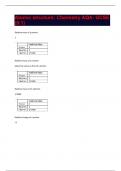
Atomic structure: Chemistry AQA: GCSE (9:1)
Relative mass of a proton 1 Relative mass of a neutron about the same as that of a proton Relative mass of an electron 1/1840 Relative charge of a proton +1 Relative charge of a neutron 0 Relative charge of an electron -1 Neutral atoms same number of positive protons as negative electrons
- Package deal
- Exam (elaborations)
- • 7 pages •
Relative mass of a proton 1 Relative mass of a neutron about the same as that of a proton Relative mass of an electron 1/1840 Relative charge of a proton +1 Relative charge of a neutron 0 Relative charge of an electron -1 Neutral atoms same number of positive protons as negative electrons
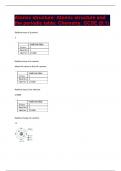
Atomic structure: Atomic structure and the periodic table: Chemstry: GCSE (9:1)
Relative mass of a proton 1 . Relative mass of a neutron about the same as that of a proton Relative mass of an electron 1/1840 Relative charge of a proton +1 Relative charge of a neutron 0 Relative charge of an electron -1 Neutral atoms same number of positive protons as negative electrons Atomic (proton) number the number of protons in the nucleus of an atom
- Package deal
- Exam (elaborations)
- • 6 pages •
Relative mass of a proton 1 . Relative mass of a neutron about the same as that of a proton Relative mass of an electron 1/1840 Relative charge of a proton +1 Relative charge of a neutron 0 Relative charge of an electron -1 Neutral atoms same number of positive protons as negative electrons Atomic (proton) number the number of protons in the nucleus of an atom
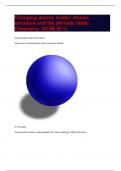
Changing atomic model: Atomic structure and the periodic table: Chemistry: GCSE (9:1)
Ancient greek model of the atom Atoms are tiny solid spheres which cannot be divided. JJ Thompson Discovered the electron and developed the "plum-pudding" model of the atom plum pudding model of the atom atoms are balls of positively charge with negative electrons embedded in it
- Package deal
- Exam (elaborations)
- • 7 pages •
Ancient greek model of the atom Atoms are tiny solid spheres which cannot be divided. JJ Thompson Discovered the electron and developed the "plum-pudding" model of the atom plum pudding model of the atom atoms are balls of positively charge with negative electrons embedded in it

DT GCSE - AQA
What are 'Mechanical Properties'? - Properties of materials, including strength, hardness, density, durability, toughness, malleability, elasticity and ductility What is 'bending'? - The ability to withstand forces that are attempting to bend What is 'compression'? - The resistance to forces that are trying to crush or shorten What is 'shear'? - The resistance to forces sliding in opposite directions What is 'tension'? - The resistance to forces pulling in opposite directions Wha...
- Package deal
- Exam (elaborations)
- • 2 pages •
What are 'Mechanical Properties'? - Properties of materials, including strength, hardness, density, durability, toughness, malleability, elasticity and ductility What is 'bending'? - The ability to withstand forces that are attempting to bend What is 'compression'? - The resistance to forces that are trying to crush or shorten What is 'shear'? - The resistance to forces sliding in opposite directions What is 'tension'? - The resistance to forces pulling in opposite directions Wha...
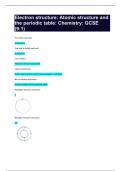
Electron structure: Atomic structure and the periodic table: Chemistry: GCSE (9:1)
First shell can hold 2 electrons 2nd and 3rd shell can hold 8 electrons no of shells = Period on the periodic table Valence electrons Outer shell electrons which are involved in reactions No of valence electrons = Group number on the periodic table Hydrogen electron structure 1 Nitrogen electron structure 2,5
- Package deal
- Exam (elaborations)
- • 3 pages •
First shell can hold 2 electrons 2nd and 3rd shell can hold 8 electrons no of shells = Period on the periodic table Valence electrons Outer shell electrons which are involved in reactions No of valence electrons = Group number on the periodic table Hydrogen electron structure 1 Nitrogen electron structure 2,5
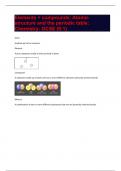
Elements + compounds: Atomic structure and the periodic table: Chemistry: GCSE (9:1)
Atom Smallest part of an element Element A pure substance made of only one kind of atom Compound A substance made up of atoms of two or more different elements joined by chemical bonds Mixture A combination of two or more different substances that are not joined by chemical bonds
- Package deal
- Exam (elaborations)
- • 5 pages •
Atom Smallest part of an element Element A pure substance made of only one kind of atom Compound A substance made up of atoms of two or more different elements joined by chemical bonds Mixture A combination of two or more different substances that are not joined by chemical bonds
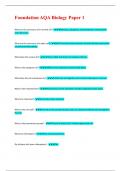
Foundation AQA Biology Paper 1
What are the structures of an animal cell? - Nucleus, cytoplasm, cell membrane, mitochondria and ribosomes. What are the structures of a plant cell? - All structures from animal cells and cell wall, permanent vacuole and chloroplasts. What does the nucleus do? - Stores DNA and directs all cellular activities. What is the cytoplasm do? - Where most chemical reactions take place. What does the cell membrane do? - Holds the cell together and controls what goes in and out. What is the mitocho...
- Package deal
- Exam (elaborations)
- • 15 pages •
What are the structures of an animal cell? - Nucleus, cytoplasm, cell membrane, mitochondria and ribosomes. What are the structures of a plant cell? - All structures from animal cells and cell wall, permanent vacuole and chloroplasts. What does the nucleus do? - Stores DNA and directs all cellular activities. What is the cytoplasm do? - Where most chemical reactions take place. What does the cell membrane do? - Holds the cell together and controls what goes in and out. What is the mitocho...
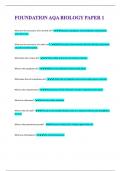
Foundation AQA Biology Paper
What are the structures of an animal cell? - Nucleus, cytoplasm, cell membrane, mitochondria and ribosomes. What are the structures of a plant cell? - All structures from animal cells and cell wall, permanent vacuole and chloroplasts. What does the nucleus do? - Stores DNA and directs all cellular activities. What is the cytoplasm do? - Where most chemical reactions take place. What does the cell membrane do? - Holds the cell together and controls what goes in and out. What is the mitocho...
- Package deal
- Exam (elaborations)
- • 15 pages •
What are the structures of an animal cell? - Nucleus, cytoplasm, cell membrane, mitochondria and ribosomes. What are the structures of a plant cell? - All structures from animal cells and cell wall, permanent vacuole and chloroplasts. What does the nucleus do? - Stores DNA and directs all cellular activities. What is the cytoplasm do? - Where most chemical reactions take place. What does the cell membrane do? - Holds the cell together and controls what goes in and out. What is the mitocho...
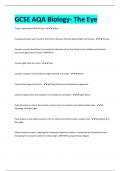
GCSE AQA Biology- The Eye
Tough supporting wall of the eye - Sclera Transparent outer layer found at the front of the eye. Refracts (bends) light into the eye - Cornea Contains muscles that allow it to control the diameter of the Pupil (hole in the middle) and therefore how much light enters the eye - Iris Focuses light onto the retina - Lens Contains receptor cells sensitive to light intensity and colour - Retina Controls the shape of the lens - Ciliary Muscles and Suspensory Ligaments Carries impulses from the r...
- Package deal
- Exam (elaborations)
- • 2 pages •
Tough supporting wall of the eye - Sclera Transparent outer layer found at the front of the eye. Refracts (bends) light into the eye - Cornea Contains muscles that allow it to control the diameter of the Pupil (hole in the middle) and therefore how much light enters the eye - Iris Focuses light onto the retina - Lens Contains receptor cells sensitive to light intensity and colour - Retina Controls the shape of the lens - Ciliary Muscles and Suspensory Ligaments Carries impulses from the r...

Geography AQA GCSE PAPER 1
Natural Hazard - A natural hazard is a natural process which could cause death, injury or disruption to humans, or destroy proprty or posesions. Natural disaster - A natural hzard that has actualy happened Geological hazards - Caused by kand and tectonic processes Meteorological hazards - Caused by weather and climate Factors affecting hazard risk - Urbanisation, poverty, development, climate change Tectonic plates - Slabs of the Earth's crust Continental crust - thicker and less dense ...
- Package deal
- Exam (elaborations)
- • 14 pages •
Natural Hazard - A natural hazard is a natural process which could cause death, injury or disruption to humans, or destroy proprty or posesions. Natural disaster - A natural hzard that has actualy happened Geological hazards - Caused by kand and tectonic processes Meteorological hazards - Caused by weather and climate Factors affecting hazard risk - Urbanisation, poverty, development, climate change Tectonic plates - Slabs of the Earth's crust Continental crust - thicker and less dense ...
